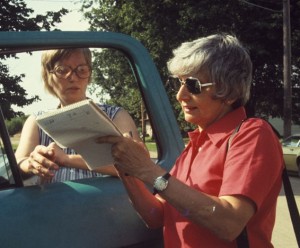One of the first archaeology books I read was Brian Fagan’s Corridors Through Time, an engaging introduction to the subject. Perhaps you have read something by Fagan. Committed to bringing archaeology out of academia and to the general public, he’s written many books geared toward a “popular†audience. These works, combining authoritativeness and accessibility, have been a real contribution to the field. Oddly enough, such works are not often recognized formally by the professional community. To address this situation, the Archaeological Institute of America, which publishes ARCHAEOLOGY, and the Center for American Archeology (CAA) have instituted an award for non-fiction writing for broad public audiences.

Felicia Holton, notebook in hand, with Alice Streuver at Koster (CAA D.R. Baston)
CAA, a nonprofit educational organization that has been around for more than 55 years, is dedicated to scientific inquiry, outreach, and stewardship of North America’s archaeological resources. As a pioneer in public outreach, the CAA engaged the interest of thousands of students of all ages who eagerly watched the “miracle in the cornfield,” as the Koster site excavations of the 1970s were called. In the course of the decade-long Koster excavations, the CAA’s commitment to outreach crystallized, leading to avocational field schools for adults and for high school and junior high school students. (Find out more about CAA and the Koster Site.) The concept is simple: honor a writer who has, through a single major publication or body of work (responsibility) represented the importance and excitement of archaeology to the nonspecialist audiences.
And so we now have the Felicia A. Holton Book Award, named for the co-author, with excavator Stuart Struever, of the popular book Koster: Americans in Search of their Prehistoric Past (1979). Holton had written for newspapers including the Wall Street Journal long before being introduced to archaeology and Stuart Struever. For nearly four years in the 1970s, she worked in Kampsville, Illinois, with Struever, other scientists, and students to tell the story of one of the most important projects in North America at that time. In a cornfield behind the Koster family farmhouse, 10,000 years of prehistoric human occupation were revealed as a large and diverse archaeology team explored the site over nearly a decade.
This was the time of “new archaeology†and the opening of archaeology to the public. The Koster site allowed people of all ages to observe the excavation; thousands of students from middle school to senior citizens actually participated. The Struever-Holton collaboration, Koster: Americans in Search of their Prehistoric Past, brought not only the result of the excavation to the public, but also illuminated the process of archaeological research that was being developed at the time. Koster was well researched and well illustrated. It talked about science and the specific archaeology of the site and brought it alive for the general public. At about the same time, Jane Goodall, Lewis Leakey, Brian Fagan, and others began to take seriously the idea of writing for the public. If not the first of its kind in North America, Koster was one of the first and most successful books of its type.
So it is fitting that AIA and CAA create the Felicia A. Holton Book Award for popular, non-fiction in archaeology in honor of her groundbreaking work. Nominations are being accepted now (deadline February 1, 2010), and the first award will be given at the AIA Annual Meeting in January 2011. Have a suggestion, a book about archaeology published recently that we should consider? Let us know! You can read more about the award criteria here.
This entry was posted by Mark Rose on
Friday, November 13, 2009.
Discussion of this blog entry is now closed.
Comments posted here do not represent the views or policies of the Archaeological Institute of America.

